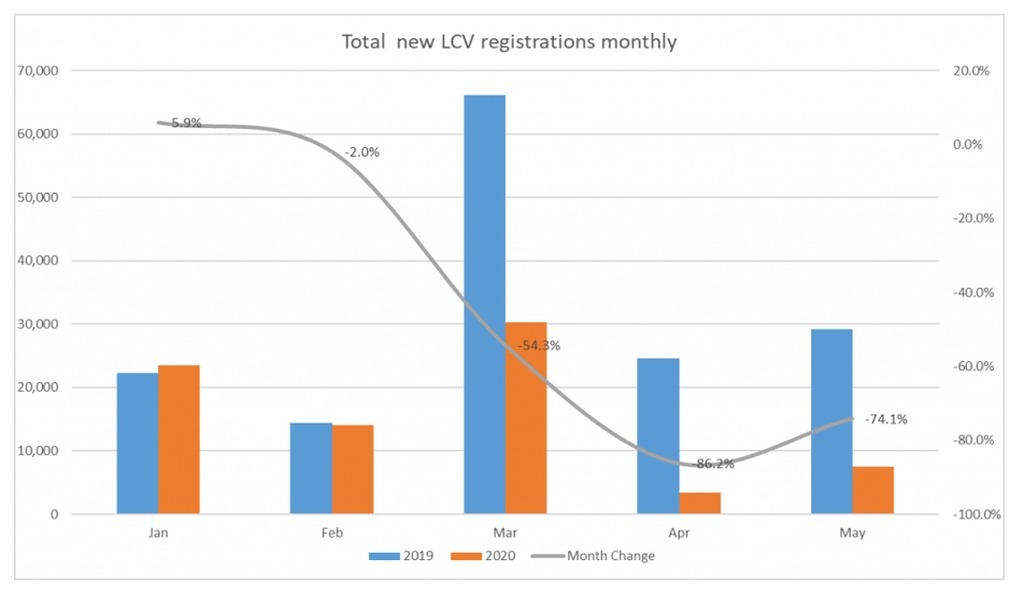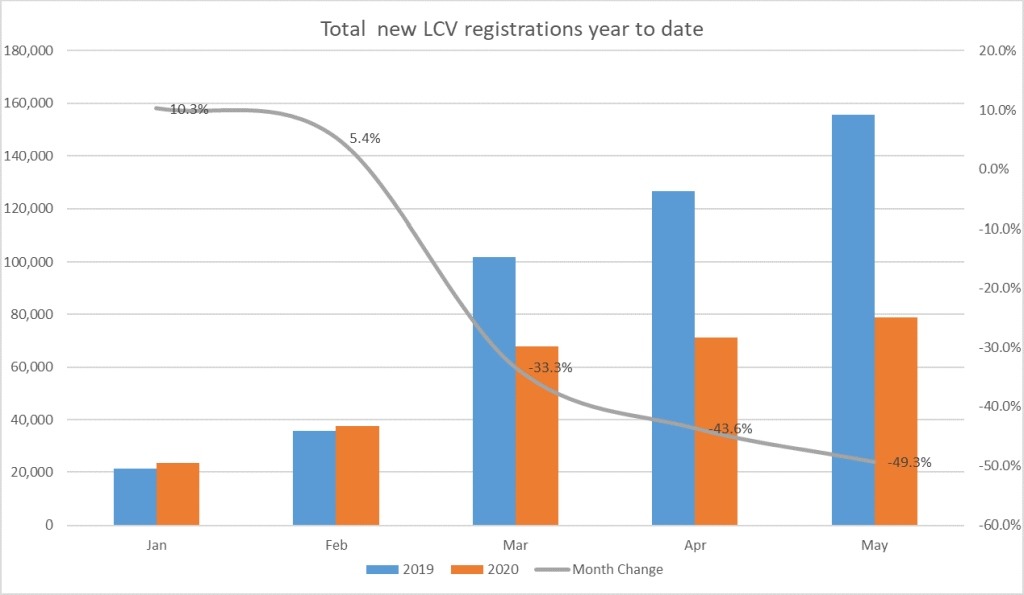The Van’s Headlights
Glass’s continues to monitor the LCV market closely and has an open dialogue with auction houses and manufacturers, leasing and rental companies, independent traders and dealers as well as the main industry bodies. This information combined with the wealth of knowledge in our CV team ensures Glass’s valuations remain relevant in the market place.
This week, the Van’s Headlights analyses the LCV market in detail, investigating vehicles in demand and the volumes sold in May.
The new LCV market
With the coronavirus lockdown continuing to affect the new light commercial vehicle market, registrations fell heavily again in May. The UK new light commercial vehicle (LCV) market declined by 74.1%. Overall, only 7,541 new LCVs hit UK roads during the month, with the majority used to further support the NHS, emergency, pharmaceutical, food distribution and home delivery services.

Performance year-to-date has declined by over 49%, with only 78,835 units registered during the first five months of 2020. Although an improvement versus April, this unparalleled crisis has resulted in further significant drops in demand across all sectors. Breaking the month down by sectors reveals registrations fell 80.3% for Pickups, 84.0% for Vans under 2.0 tonnes, 78.7% for Vans between 2.0-2.5 tonnes and 70.4% for Vans between 2.5-3.5 tonnes.

Top five LCV registrations

The latest April SMMT new LCV registrations re-forecast for 2020 is down 28% to 263,000 units for the year. Lockdown is affecting everyone from the smallest trader to the biggest fleet, with many struggling to remain in business.
The used LCV market
Auction houses started reopening online sales from the middle of May. With the majority of auction locations stocking vehicles from before the March lockdown, the initial aim was to move this dormant stock as quickly as possible.
Glass’s auction data suggests May sales were down 58% versus May 2019. However, already in June, UK auction buyers are adapting to the online world with sales and first-time conversion rising quickly. As logistics become accessible, more used LCVs will become available in the auction channels increasing supply at a time when buyers have growing confidence in buying at online sales.
As online sales programmes increase, there is a definite appetite from trade buyers to purchase good quality stock. Supporting this appetite is data showing average prices across all ages and sectors rose 22.6% versus May last year.
Physical auction sales restart from the June 15; however, many buyers are reluctant to rush back to the rostrum, with social distancing, safe vehicle movement and deep cleaning of all surfaces a continuing issue.
May auction sales in detail
The average age of sold stock in May fell dramatically from 83.0 months in April to 59.9 months. This figure was also 9.6 months lower than the same point last year.
Average first-time conversion rates stand at 54.9%, up from 33.3% in April, but down from 71.7% 12 months ago.
Average vehicle mileage for those that sold stands at 65,758 miles, a decrease of 5,861 miles on April and more than 13,600 miles less than May 2019.
The interconnected nature of the UK economy means that the coronavirus crisis is affecting everyone. For over two months, new and used LCV sales have been on hold, but dealerships and auction houses are slowly starting to reopen with social distancing measures, deep cleaning and appointment bookings as the new norms across the industry.
The new normal – post Covid-19
Restoring confidence in the economy will be critical if operators are to resume some sort of business ‘normality’ moving forward. There has been a slow but gradual increase in fleet renewals of late, but confidence in the economy is critical if they are to continue to reinvest in the cleanest fleets.
With our current data, and assessing data from significant recessional periods in the past we are confident that the UK market has the potential to come back strongly and relatively quickly. As an island that drives on the left, there will be specific supply constraints for the UK which will continue to affect the availability of new LCVs.
The supply of new LCVs could be further curtailed as we negotiate the UK trade deals with Europe. These trade deals are likely to negatively affect the Euro / Pound Exchange rate further increasing the price of new vans and pick-ups, whilst at the same time positively affecting the demand for used LCVs.
As unemployment continues to rise the makeup of the demand in the LCV market is likely to change with it. Firstly, additional unemployment is likely to force a further contraction in the new LCV market. Conversely, this is likely to increase demand in the used LCV market potentially strengthening the recovery of used LCV values, this was last witnessed during the 2008 financial crisis.

 Close
Close